With just about every holiday AAA game having hit store shelves already, the gap between Black Friday and Christmas is usually fairly barren for new releases. Kids have made up their minds by now, and ad execs have their marketing money accounted for. It would take something huge for a company to release a game in the final hours of the shopping season.
Did we say huge? We should have said small. Hand held. Portable. Instead of fighting the AAA hordes for shelf space, there’s a level playing field on the eShop; kids receive 3DS systems as gifts and look to download all kinds of new games, and Nintendo doesn’t necessarily divide the games into retail and digital categories.
Those kids would do well to pick up SteamWorld Heist, then, as the game not only carries a huge adventure worthy of its brick and mortar brethren, it also comes wrapped in some of the most charming stylings possible. One of the best original 3DS games of 2015 arrives at the tail end of the year, sneaking in just before Saint Nicholas’ sleigh does the rounds. It just so happens to be one of the most challenging, tense and freshly unpredictable 3DS games as well.
Image & Form’s SteamWorld Heist, the spiritual successor to SteamWorld Dig, has been in production for a while now, with the team focused on taking the original’s steampunk IP and painting it onto a new genre. And it works. This game is a 2D strategy affair, relying on teams of steambot characters and turn-based action in a planar world. That 2D design is misleading, however. It may be simple in visual appearance but it’s much more complex than it leads on. The developers have pushed themselves to go further than Dig, ultimately resulting in a game that’s oozing depth and minutiae. The only remnants of its predecessor are perhaps the charming IP (Dig and Heist take place in the same steampunk universe, albeit decades apart) and the use of randomly generated 2D maps for each level.
In Heist, players command teams of characters around a level, using limited movement and coordinating actions; moving within the orange zones allows actions, while the extended blue ones only account for defense. This forces players to make wiser decisions based on loot drops and enemy locations, doors and cover. Running and gunning isn’t always an option, as heading into a scrapper-congested area can lead to a quick death.
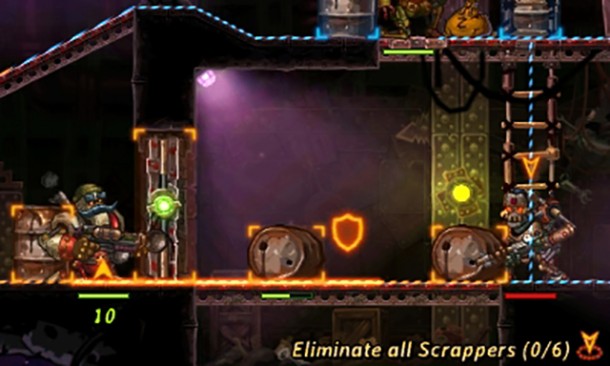
Attacking itself takes precision and patience as an action. Heist asks us to manually aim our weapons, and with every weapon acting differently (some with laser sights, others more arc-like) it requires not only properly positioning ourselves on the play board, but also carefully aiming our guns. I found myself tapping up and down on the D-pad incrementally with almost every shot, and not always taking into account the environment that can cause me to missfire.
Added to this mechanic is the game’s class-like system of characters: snipers, heavies, technicians and healers provide a little bit of differentiation in how teammates move, attack and what they can and can’t equip. They’re not incredibly unique, but they’re dissimilar enough that adjusting the pre-match weapon and item loadouts can force every battle to be approached differently. Some items can turn a technician into a balanced healer, while others into close-proximity heavies. Innovating with items — which are gained through loot drops or purchase at any of the endless shops in the game — can lead to interesting gameplay results. One of my favorite pairings included a souped up melee-enhancing gauntlet with a damage inducing vest, causing hand-to-hand combat to always go my way.
“It’s because of this balance of control and surprise that the tension is so great.”
It’s important to manage teams very carefully and to know who is moving where and doing what, and where the enemies are. I’ve been cramming Hearthstone a lot lately, and I’ve noticed that I’ve been playing my Heist teams in a similar way. One of the modifiers that Piper, the game’s main protagonist, has is named “Inspire”. Inspire enhances the actions of adjacent teammates, sometimes doubling or tripling attacks or healing. By using Inspire and moving around the level in doubles, my team can pulverize enemies we come across. However, we’re also left open for damage to both of us should a scrapper throw a grenade and hit us both.
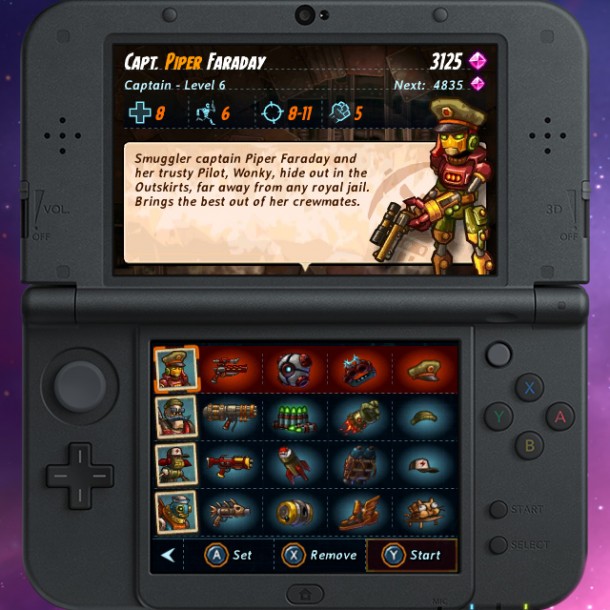
Characters have set upgrade paths & statistics. It feels frustrating at first — I’m the kind of gamer that really likes to homogenize my teams — but once we get used to it, it gets us to try different combinations and learn the steambots’ strengths and weaknesses.
Though teammates are easy to coordinate, enemy movement isn’t as clear. This can be good or bad, as it leaves us always wondering about what their movement & attack limits are. Through a bit of practice and a little observation, I try to learn to goad the enemies into specific locations and to go after certain teammates, which helps me manage the battlefield. That makes strategy important, but luck is sometimes just as much so. Depending on the difficulty level, the game’s enemies have AI quirks, and will even make a mistake and miss shots. Nothing is more satisfying than being low on HP and about to lose a teammate when a scrapper’s shot misses and ricochets around, hitting an exploding barrel behind them for what can seem like a Christmas present out of nowhere.
It’s because of this balance of control and surprise that the tension is so great. It makes battles, even those overpowered on one side or another, act as their own little unique experience. As my characters become stronger I know I can probably win a specific battle, but I don’t know if I will lose teammates or not, or make some grave mistake along the way.
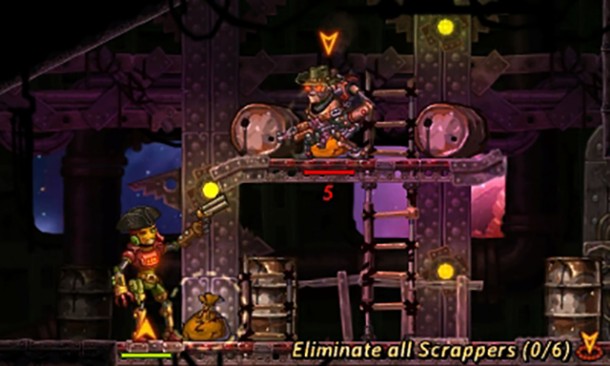
There is a lot of complexity in Heist and what seems like a lot of rules, but it’s also surprisingly simple and requires no real learning at all.
Because the levels aren’t massive (at least the early ones) they move relatively quickly, and it’s easy to pick up and play one or two at a time while on break between meetings at the office (please don’t tell my boss). Being able to adjust the difficulty at the beginning of battles is helpful. Losing can lead to paying a hefty in-game “fine”, and repeatedly doing so can quickly drain funds. The game can get frustrating at times, especially if our team hasn’t leveled up enough and increased health or strength. Adjusting the difficulty up or down from Regular can feel almost like a requirement later in the game, unless we opt to grind a bit and improve our team.
All of this is wrapped in the incredibly charming art direction that Image & Form is known for. Heist is a pretty, pretty game. The visuals are great, relying on hand-drawn characters and environments that seem to float in layers in front of the vastness of space. There aren’t a ton of games that take advantage of the 3DS’ core gimmick, but I couldn’t help but want to play this game exclusively with the effect cranked all the way up. It’s also fairly amazing that the procedurally generated worlds still look and feel great even with their randomness. It never once feels like they are pieces stuck together with duct tape; they’re coordinated well, logical, and offer enough surprise and delight that I’d swear Image & Form are pulling our legs and just have thousands of them made ahead of time, pulling them as needed.
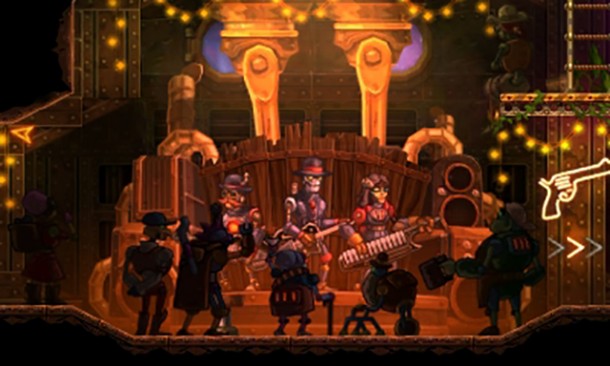
The characters themselves are interestingly designed. With the premise that everyone in this world is created from spare mechanical parts, it lets the designers have sort of free rein in developing their looks, right down to details like the placement of nuts and bolts. They’re not only fun to look at, but fun to listen to as well. Heist has great audio, pushing the aging portable to its limits. Each character has their own robotic voice: whether it’s tinny or heavy, gravelly or echoing, the voices sound as randomized as possible, yet are quirky and enjoyable. That’s purely a design choice, too, as there’s an actual in-game band with real vocals that plays in the bars. The game’s soundtrack was coordinated by the band Steam Powered Giraffe, and they’ve not only done an excellent job of creating a tight playlist, but the’ve managed to squeeze in some of their songs as well.
“The level generation is impressive; each one builds tension and danger and never feels over-designed. It’s wizardry.”
With SteamWorld Heist, we’re never playing the same game twice. The characters are memorable, the gameplay easy to pick up, and the plot is basic but enjoyable. It can get frustrating at times, but the ability to change difficulty at the beginning of each battle is a welcome way to subvert that. The level generation is impressive; each one builds tension and danger and never feels over-designed. It’s wizardry. The New Game + mode further adds a novelty to it. SteamWorld Heist is a great step in for those inexperienced with strategy games, and those who are veterans will find a lot to do and plenty of challenge. Image & Form love Nintendo devices, putting as much emphasis on creating a terrific and accessible game experience as the Big N itself. They’ve managed to craft a game that is one of the best to appear on the 3DS.
This review is based on a retail eShop code sent to SideQuesting by the publisher. The reviewer Dali is an avid 3DS gamer and a fan of 2D and retro-inspired games. He also reviewed the original SteamWorld Dig. The game will be arriving on other consoles and devices in 2016.

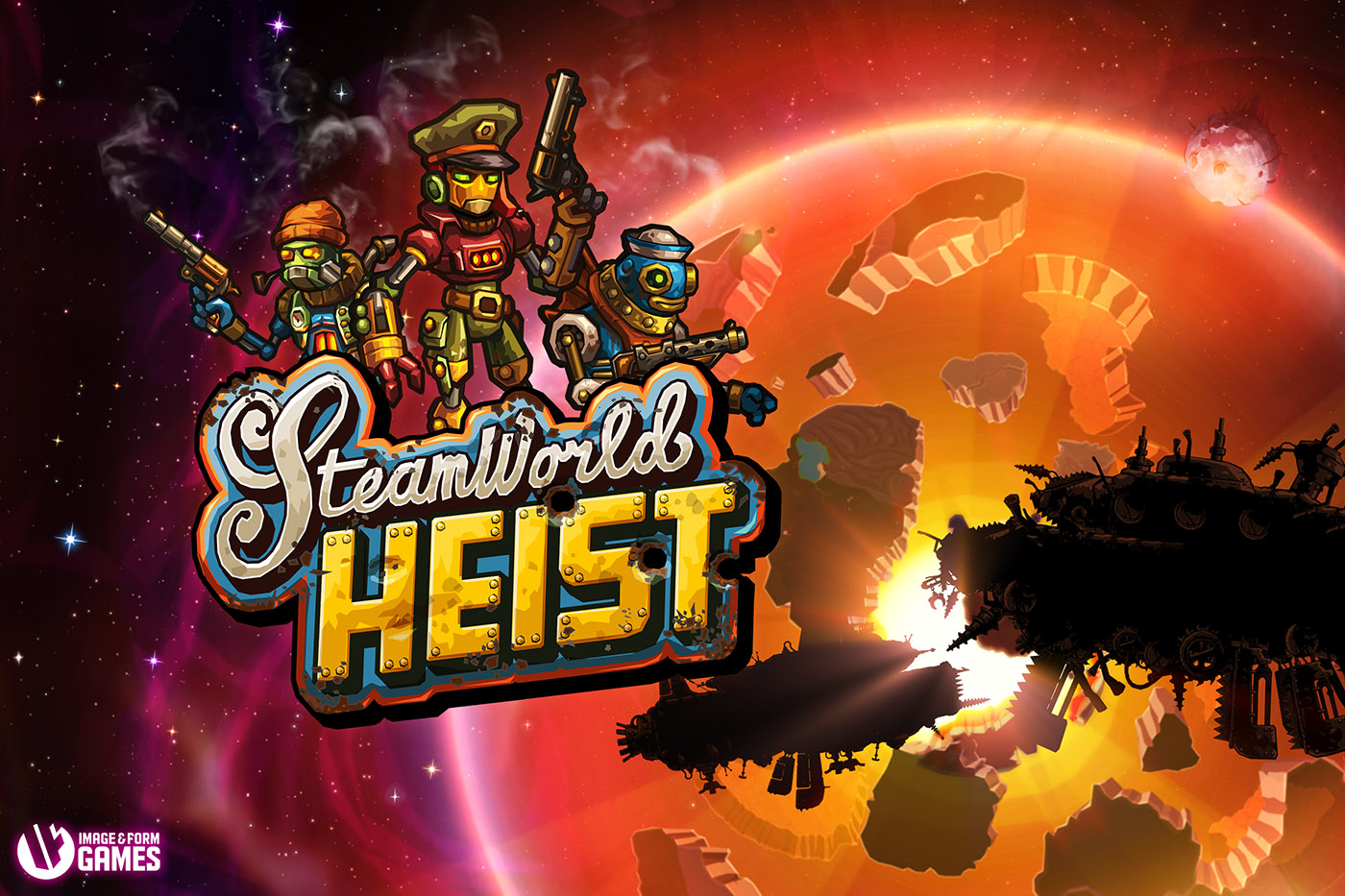
No Comments